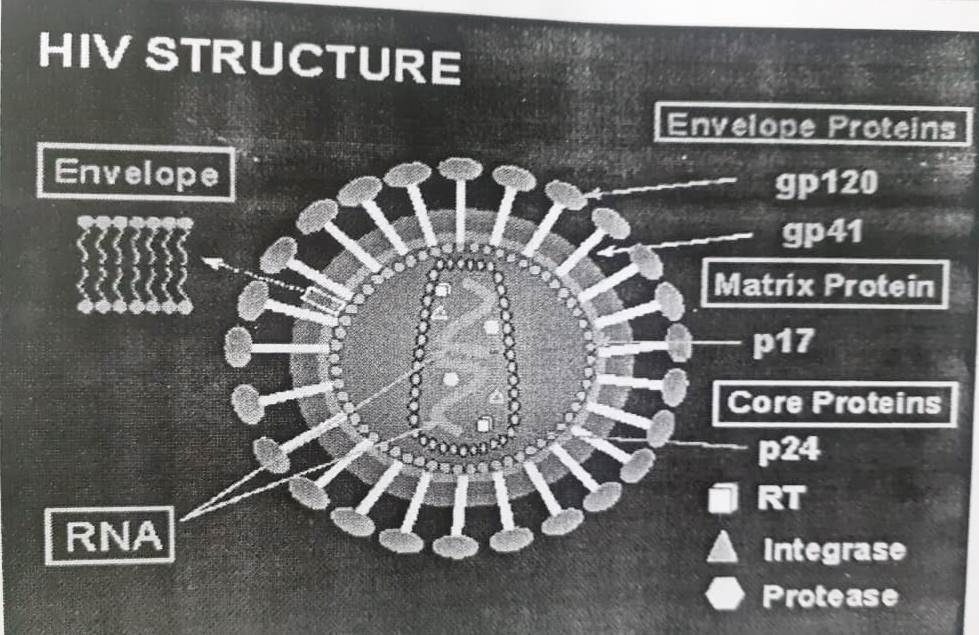V-Virus (A type of germ).
Virus structure
 |
| HIV Virus Structure
|
HIV TRANSMISSION
ROUTES OF SPREAD OF HIV:
1.Unprotected sexual contact either vaginal/anal/oral.
2.Transfusion of untested blood or blood products.
3.Skin piercing instruments-unsterilized sharps-needle, syringe, blades, dental/surgical instruments.
4.HIV infected parents to child.
WHICH FLUIDS CAN TRANSMIT HIV?
1.Infected blood of HIV+ve people.
2.Infected Semen.
3.Infected vaginal secretions
4.Infected breast milk of mother
NOTE:-Saliva, Sweat, Urine, Stool and Vomitus does not spread HIV, unless mixed with blood.
HOW DO WE KNOW IF ONE IS HIV+ve
1.HIV Test is done on a single sample of blood
2.Before declaring a person HIV+ve, the sample is tested 3 times by three different testing kits.
3.HIV Test is +ve after the window period.
4.Testing is available at ICTCs (Integrated Counselling and Testing Centres).
DURING WINDOW PERIOD:
1.Client should be counselled before and after the test.
2.The test results should be maintained confidential.
CAN A PERSON HAVE AN HIV INFECTION EVEN THOUGH THE TEST IS NEGATIVE!
1.YES! HIV test detects anti-bodies.
2.If a person does the test early after getting infected, she/he will not enough of antibodies to be detected. This is called WINDOW PERIOD.
3.During Window period the person may be HIV infected.
4.During window period the Viral Load is very High hence the person could be very infectious.
5.For ones confirmation of HIV status, the HIV test should be repeated after 4-6 weeks.
6.Other test such as PCR or P24 antigen could be done. These tests are costly and are not available at the ICTC.
AIDS
A:ACQUIRED(Got-not caught)
I:IMMUNO(Immune or defence system)
DEFICIENCY(Depletion/decrease)
S:SYNDROME(Group of signs/symptoms)
Progression of HIV Infection to AIDS
Infection➜Window period➞HIV+ve Asymptomatic period➞HIV+ve Symptomatic →AIDS
SIGNS AND SYMPTOMS OF AIDS
Significant weight loss (>10% in 1 month).
Chronic Diarrhoea lasting for more than 1 month.
Prolonged fever lasting for more than 1 month.
Unusual or severe forms of Tuberculosis (TB)
Fungal infection (white patches) in the mouth and throat.
Life threatening or recurrent pneumonia.
Infections of the brain.
Sudden Decrease of vision in young persons.
Recurrent or severe skin infections.
PREVENTION OF HIV/AIDS
HOW CAN WE PREVENT HIV?
1.Prevent sexual transmission.
2.Prevent blood borne transmission.
3.Prevent transmission from used needles and syringes.
4.Prevent infected parents to child transmission.
NO effective vaccine against HIV has yet been identified
PREVENTION OF SEXUAL TRANSMISSION:
Complete treatment of STI.
Adopt safer sex method.
PREVENTION OF BLOOD BORNE TRANSMISSION OF HIV:
Avoid unnecessary blood transfusions, injections and IV fluids.
Insist on the blood or blood products being tested for HIV before accepting for transfusion.
Use new or sterile blades, razors, scissors, dental or surgical instruments.
Use new or sterile needles and syringe for each injection.
NOTE:-Never reuse disposables. Eg-IV fluids sets.
PREVENTION OF PARENT TO CHILD TRANSMISSION OF HIV
The chances of the baby getting HIV from mother is only 30-35%.
This can be reduced by giving ART medicines to the mother and the baby at the time of delivery.
Caesarean section reduces the chances of HIV transmission to the baby.
These services are available PPTCT(Prevention of Parent To Child Transmission) centres in medical colleges and District Hospitals.
TREATMENT OF AIDS
There is treatment available for AIDS, however there is no cure.
Treatment can prolong life and improve the quality of life.
Treatment has side effects and complications.
Treatment once begun has to continue lifelong.
WHERE SHOULD A PERSON WITH HIV BE REFERRED FOR TREATMENT:
Any person testing HIV positive -referred for registration at ART centre.
At centre-Screening for various symptoms based on which the person is clinically staged as stage i, ii, iii, or iv. CD4 test also done.
Clinical Stage III+CD4 Count <200, or Clinical Stage IV+CD 4 count<350=required ART.
ANTI-RETRO-VIRAL THERAPY:
Combination of at least three anti-retro-viral drugs.
To be taken life long once it is started and at the same time every day.
ART adherence rates must be more than 95% for the medicines to be effective.
ART medications do have side effects and complications, patients must be observed and monitored for these side effects and complications.
CAN HIV INFECTION OR AIDS BE CURED
NO! There is no cure for HIV and AIDS.
ART helps to increase the duration and quality of life. Complimentary treatment includes yoga, meditation, diet and exercise.
Taking care of an HIV person does not put one at greater risk of HIV infection.
People living with HIV need care and compassion to deal with their illness.
WHAT ARE OPPORTUNISTIC INFECTION?
Occur commonly among people living with HIV and AIDS-Commonest OI is TB.
To prevent some common OI that can be life threatening. PLHIV are sometimes prescribed cotrimoxazole,
Single daily dose-prevents at least three common life-threatening OI.
OI prevention-continued until person is put on ART and CD 4 comes back to acceptable levels.

